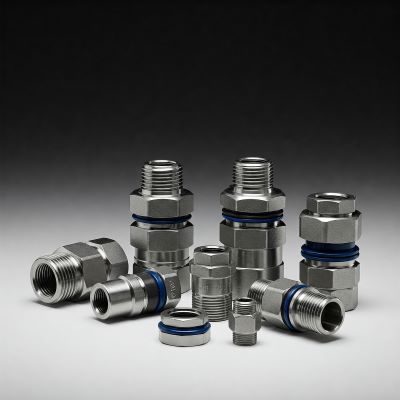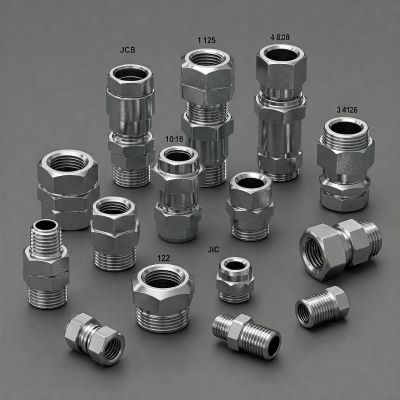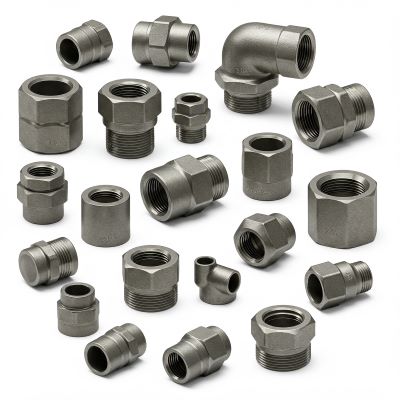Choosing the right thread type for your hydraulic or plumbing application is crucial for ensuring leak-free and reliable performance. A seemingly small detail like thread type can have a significant impact on the overall system’s functionality and safety.
This article compares three common thread types – NPSM (National Pipe Straight Mechanical), JIC (Joint Industry Council), and NPT (National Pipe Thread) – to help you make an informed decision.
Understanding NPSM, JIC, and NPT Fittings
What Is NPSM Thread?
National Pipe Straight Mechanical (NPSM) thread is characterized by their straight (parallel) design. Unlike tapered threads, NPSM fittings don’t create a seal on their own. They rely on a separate metal-to-metal seat (often a cone) or an O-ring to prevent leaks. NPSM fittings are commonly found in hydraulic and plumbing systems where a reliable, leak-free connection is essential, but not necessarily under extremely high pressure.
What Are JIC Fittings?
Joint Industry Council (JIC) fittings are known for their distinctive 37-degree flare seating. This flare, combined with the fitting’s design, creates a robust metal-to-metal seal without the need for thread sealing compounds. JIC fittings are the go-to choice for high-pressure hydraulic systems, fuel lines, and aerospace applications where reliability under extreme conditions is paramount.
What Are NPT Fittings?
National Pipe Thread (NPT) fittings are easily identified by their tapered threads. This taper is what allows NPT fittings to create a seal. As the fitting is tightened, the tapered threads wedge together, creating an interference fit. However, this seal isn’t perfect on its own; it requires PTFE tape (Teflon tape) or pipe sealant to fill any microscopic gaps and ensure a leak-free connection. NPT fittings are commonly used in gas, water, air, and lower-pressure hydraulic systems.
Key Differences Between NPSM, JIC, and NPT Fittings
|
Feature |
NPSM |
JIC |
NPT |
|
Thread Type |
Straight (parallel) |
Straight (flare-seal) |
Tapered |
|
Sealing Method |
Metal-to-metal seat or O-ring |
37-degree flare |
Thread deformation with sealant |
|
Leak Prevention |
Needs a seat or O-ring |
Self-sealing flare |
Requires PTFE tape or sealant |
|
Best for High Pressure? |
No |
Yes |
No |
|
Common Applications |
Hydraulic, plumbing |
High-pressure hydraulics, aerospace |
Low-pressure gas, water, air |
Pros and Cons of Each Thread Type
NPSM Fittings
✅ Pros:
-
Easy to install and remove.
-
Less chance of thread damage compared to NPT.
-
Works well with O-rings for a reliable seal.
❌ Cons:
-
Not inherently leak-proof without an additional seat.
-
Not suitable for very high-pressure applications.
JIC Fittings
✅ Pros:
-
Strong metal-to-metal seal eliminates the need for thread sealant.
-
Handles high-pressure applications well.
-
Highly resistant to vibration and mechanical stress.
❌ Cons:
-
More expensive than NPT and NPSM.
-
Requires precise flaring tools for proper installation.
NPT Fittings
✅ Pros:
-
Simple, widely used, and cost-effective.
-
Thread deformation creates a tight seal (when properly sealed).
-
Works well in low-pressure fluid and gas systems.
❌ Cons:
-
Requires sealant to prevent leaks.
-
Prone to galling (thread damage) with frequent assembly/disassembly.
-
Not ideal for high-vibration environments.
Choosing the Best Thread Type for Your Application
For high-pressure hydraulic systems: Use JIC fittings. Their robust design and flare seal are ideal for demanding applications.
-
For plumbing and moderate-pressure hydraulic systems: Use NPSM fittings. They offer a good balance of ease of use and reliable sealing.
-
For low-pressure air, gas, and water systems: Use NPT fittings. They are a cost-effective and readily available option for basic plumbing and gas lines.
-
For systems exposed to frequent assembly/disassembly: Avoid NPT if possible to minimize the risk of thread wear and galling. Consider NPSM or JIC if the application allows.
Final Thought
There’s no single “best” thread type. Your unique demands will determine which option is best for you. JIC fittings excel in high-pressure, vibration-prone environments. NPSM fittings provide reliable sealing in moderate-pressure systems. NPT fittings are suitable for basic plumbing and gas lines. Understanding the strengths and weaknesses of each thread type is crucial for preventing leaks, ensuring system integrity, and avoiding costly repairs.
Call to action: Before starting your next project, carefully consider the pressure requirements, sealing needs, and ease of installation for your application. Choosing the right fitting is essential for preventing leaks and ensuring the long-term reliability of your system. Don’t hesitate to consult with a professional if you’re unsure which thread type is best for your specific application.
Post time: Jan-31-2025




